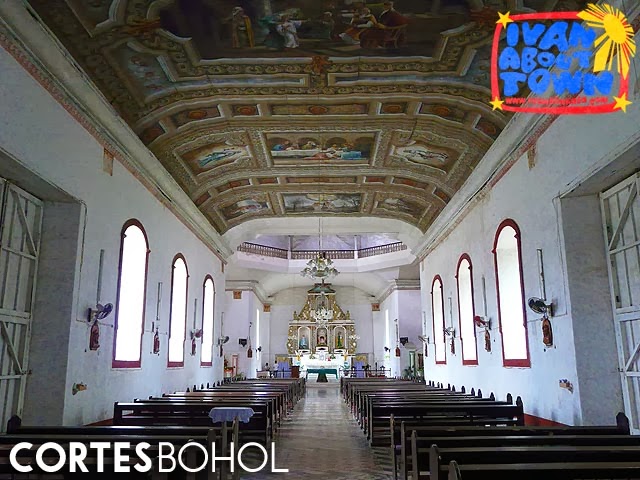The Diocese of Tagbilaran has always been exemplary when it comes to heritage conservation. In fact, they are the only diocese in the country actively getting their churches declared, thanks to the efforts of Fr. Ted Torralba. Which explains why they have more than ten properties
declared as National Cultural Treasures or National Historical Landmarks within their diocese alone.
Being declared properties, the NCCA and its attached agencies will have a lot to do with the restoration of many of the churches damaged by the October 15, 2013 earthquake in Central Visayas. But the effort will mainly be an undertaking of the Diocese of Tagbilaran which covers the southern half of Bohol Province.
A new bank account was created solely for contributions to the reconstruction and restoration of Bohol's churches. Donations are now accepted:
Account Name: The Roman Catholic Bishop of Tagbilaran
Account No. 123-3-123-51030-6 / Metrobank (Tagbilaran Branch)
To get a receipt for your donation, e-mail your deposit slip to the Diocese of Tagbilaran thru j_asion@yahoo.com or fax to (038) 4115653. List of donors will be published. When the plan developed by the Heritage Task Force is in place and implemented, expenses will also be published.
Fr. Ted Torralba answers some FAQs about the restoration and donations below:
1. How the restoration will be undertaken and who will be on board?
The Diocese of Tagbilaran has a long-standing commitment with the NCCA, NHCP, and the NM to abide by accepted national and international standards of heritage conservation. It has a functioning Diocesan Commission for the Cultural Heritage of the Church established in July 1995, predecessor to an earlier diocesan committee for church restoration created in 1993, to monitor intervention on heritage churches, implement the cultural heritage law of the Church and of the Government, and recommend approval of any heritage intervention, subject to the authority of the Bishop of Tagbilaran who has the final decision on the pastoral care of heritage resources. Its activities in the area of the pastoral care of the cultural heritage resources of the Church prompt the creation of the CBCP Permanent Committee of the Cultural Heritage of the Church and advanced the preparation of the
Holy See - Philippines international agreement on the cultural heritage of the Catholic Church in the Philippines.
In the present circumstances, it awaits the results of the rapid assessment of the NCCA Heritage Task Force (coordinated by the undersigned) which is expected to be released this coming Monday, 21 October. The Diocese will abide by the restoration and/or reconstruction plan developed by the said Task Force. It awaits the rapid creation of the Task Force's field office headquartered at the NM's branch in Tagbilaran opposite the Tagbilaran Cathedral. Aside from technical experts from the National Government cultural agencies, the Diocese fields its Sacred Architecture Committee members as collaborators with the Task Force's field office. This said committee is one of five under the Diocese's Commission for the Cultural Heritage of the Church. It is constituted of four architects trained in heritage conservation and two structural engineers.
2. What form of cooperative engagement will we have here?
MOAs will be signed on Thursday between the NM (which has jurisdiction over all the declared churches in the Diocese), the Provincial Government of Bohol, and the Diocese of Tagbilaran. The MOAs come under the umbrella of
R.A. 10066 and the above-referenced
Holy See - Philippines international agreement. Bilateral or multilateral agreements will subsequently be entered into with other National Government cultural agencies as the needs arise.
3. How will the donations be managed and reported?
On the matter of donations to the Diocese of Tagbilaran for restoration and reconstruction, all will be receipted and accounted for. List of donors will be published from time to time as well as expenses incurred during the restoration process. The Diocese has the time-honored custom of printing in the weekly news bulletins of its parishes all the donations, tithes, offerings given and the expenditures incurred. It will do the same for this massive project.
Built heritage damaged by Central Visayas earthquake
This is a list of built heritage damaged during the October 15, 2013 earthquake that hit Central Visayas. This list is not limited to religious structures. Please update this list by commenting below.
Declared properties: NCT - National Cultural Treasure; NHL - National Historical Landmark; ICP - Important Cultural Property; HH - Heritage House
Bohol
Alburquerque Church (ICP) - minimal damage
Baclayon Church (NCT & NHL) - facade & belfry collapsed
Balihan Watchtower (NCT) - totally destroyed
Bohol Capitol (ICP)
Carmen Church - nave with ceiling murals collapsed
Clarin Church - church collapsed
Clarin House, Loay (HH)
Cortes Church - facade collapsed
Dauis Church (NCT & NHL) - facade collapsed
Dimiao Church (NHL) -
Inabanga Church - facade left standing
Loay Church (NHL) - facade collapsed
Loboc Church (NCT & NHL) -
Loon Church (NCT & NHL) - totally destroyed
Maribojoc Church (NCT & NHL) - totally destroyed
Maribojoc Presidencia
Panglao Watchtower (NCT) - roof fell in
Punta Cruz Watchtower, Maribojoc (NCT)
Tubigon Church - facade collapsed
Cebu
Argao Church (NHL) - minor damage, baluster of belfry gave way
Basilica Minore del Sto. Nino - belfry collapsed
Carcar Church - big crack in belfry; may collapse
Cebu Cathedral - aesthetic damage to facade
Dalaguete Church (NHL) - heavy damage to belfry and pediment; may collapse
Fort San Pedro - heavy damage to walls
Sibonga Church - some cracks
Related articles
FAQs on church heritage conservation in the Philippines
Bohol: Visita iglesia, heritage churches and watchtowers

































































